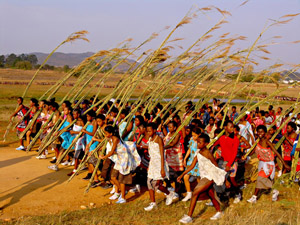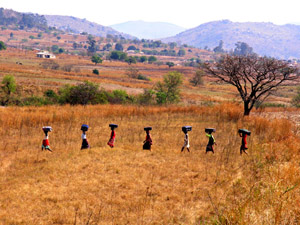Swazi Culture: The Umhlanga or Reed Dance
In an eight day ceremony, girls cut reeds and present them to the queen mother and then dance. It is done in late August or early September. Only childless, unmarried girls can take part.
The aims of the ceremony are to:
1. preserve giris' chastity
2. provide tribute labour for the Queen mother
3. produce solidarity by working together.
The royal family appoints a commoner maiden to be "induna" (captain) of the girls and she announces over the radio the dates of the ceremony. She will be an expert dancer and knowledgeable on royal protocol. One of the King's daughters will be her counterpart.

Day 2: The girls are separated into two groups, the older (about 14 to 22 years) and the younger (about 8 to 13). In the afternoon, they march, in their local groups, to the reed-beds, with their supervisors. The older girls often go to Ntondozi (about 30 kilometres) while the younger girls usually go to Bhamsakhe near Malkerns (about 10 kilometres). If the older girls are sent to Mphisi Farm, government will provide lorries for their transport. The girls reach the vicinity of the reeds in darkness, and sleep in government-provided tents. Formerly the local people would have accommodated them in their homesteads.

Day 4: In the afternoon the girls set off to return to the Queen Mothers village, carrying their bundles of reeds. Again they return at night. This is done "to show they travelled a long way".

Day 6: First day of dancing, from about 3 to 5 in the afternoon. The girls drop their reeds outside the Queen Mothers quarters. They move to the arena and dance keeping in their groups and each group singing different songs at the same time.

Day 8: King commands that a number of cattle (perhaps 20-25) be slaughtered for girls. They collect their pieces of meat and can go home.
The Reed Dance developed out of the old "umcwasho" custom. In "umcwasho", all young girls were placed in a female age-regiment. If any girl fell pregnant outside of marriage, her family paid a fine of one cow to the local chief. After a number of years, when the girls had reached a marriageable age, they would perform labour service for the Queen Mother, ending with dancing and feasting.

